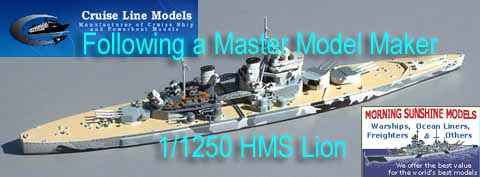| It seems that making the holes for the wires representing
the barrels is also a problem, and I was not told exactly how this is managed.
Dave uses magnifying tools, and has drill bits that are little larger than
hairs. Indeed, the Neptun 20mm quad German mount has some of the finest
guns to be seen, but rendering AA barrels in exact 1/1250 scale is impossible
because of the casting problems involved. It is difficult to get metal
or resin to flow into tiny mold openings -- even under very high pressure
gradients (vacuum or centrifugally induced). The large picture below is
blown up perhaps 40 times. The barrels are actually less than 0.18 mm thick,
but at this magnification, everything becomes blurry. The material properties
of the alloys or resin being used become very important here. It is interesting
to watch the process unfold, and I am sure that the stage will soon be
reached where the barrels cannot be made finer and still cast. I am hoping
that Alain or one of the other recognized experts in this area spells out
the limitations of what can be achieved. I have no idea what they are... |
| In resin casting there are no limitations to get the finest
parts from the mold itself if one uses appropriate products and processes.
The print capability is unimaginable and unlimited. Just consider that
some can get a perfect cast of a natural flower with petals and pistils!
The limits are rather in the caster himself to be skillful and imaginative
enough to make the mold concept successful -- and this is the trick, not
to say “secret” of fabrication.
Decisive also is the chemical resin choice: much more difficult to work,
depending on many parameters. That being said, only your experience will
limit what you can get. Here again the right resin, well processed, has
no technical limits. But for frail parts (generally latticed ones) they
will be thicker, or metal needles reinforced at casting, just as alloy-cast
models are thicker and not in scale (generally small barrels, masts, rails).
Resin can cast one hair, but not so with alloy casting - don't expect one
to do what the other can do, and vice-versa. Technically, all is possible
with resin properties, but the worktime cost for it makes it impractical,
and to reach one hair size in casting you could lose your own last hair
as the price to pay for it... ;-)
Vacuum high pressure does not exist in model casting if correct production
process are used, above all because it is question of dispressure involved,
not pressure. Physics law in dispressure makes it impossible to achieve
more than 1 kilo per cubic centimeter, even where a total vacuum is obtained.
You could not get "twice" a total air empty! Empty is empty!
There is no air anymore in a confined volume at 1 kilo dispressure. So
1 kilo dispressure isn't high. A little more about that technique is to
know that in physics, a perfect vacuum is impossible to get on earth atmosphere
surface except by the very high technology such as NASA laboratories. But
there is no need of that since only about -750 grams dispressure is enough
for a model maker. If not, your resin isn't the right one and you will
get poor results. I must warn users that that sort of armoured dispressure
caisson has a risk of implosion. Indeed, addition of suction power in it
for each cubic centimeter contained in the caisson volume (1 kilo/cm) and
glass parts for some are too feeble to resist the 500 kilos possible maximum
of your dispressor machine (almost as much as your car weighs!) If
the caisson would come to break "your nose," watching operations in it
you could be "vacuumed in the box" with serious injury! (Same effect
as brutal airplane dispressure for passengers expulsed outside through
portholes...)
Your Pom-Pom barrels’ scale level George are not so bad. If you consider
the one/one scale of the real guns this would give a diameter for them
in 1250 scale of about 0,12 mm thick. Your master of 0,18 mm isn't so far
of what human eye could see in so small and makes no difference!
Even the thickness difference of 0,06 mm too big would be that of the paint
covering thickness!
There is no point doing gun holes for anything smaller than 15 inches
main artillery in 1250 scale since one couldn't see them. To drill a gun
hole at our "micro-scale" use a tender material rather than copper thread,
or too hard a material. Silicone will do the rest, and don't forget that
in such tiny work in 1250 the principle is that it's the part going to
the tool, not the tool going to the part, as in bigger scales of modeling.
Thank you George for your interesting and positive animations you provide
in your postings, in appreciation of all you bring to the Board. Their
whole support they expressed could not say best.
Alain
|

